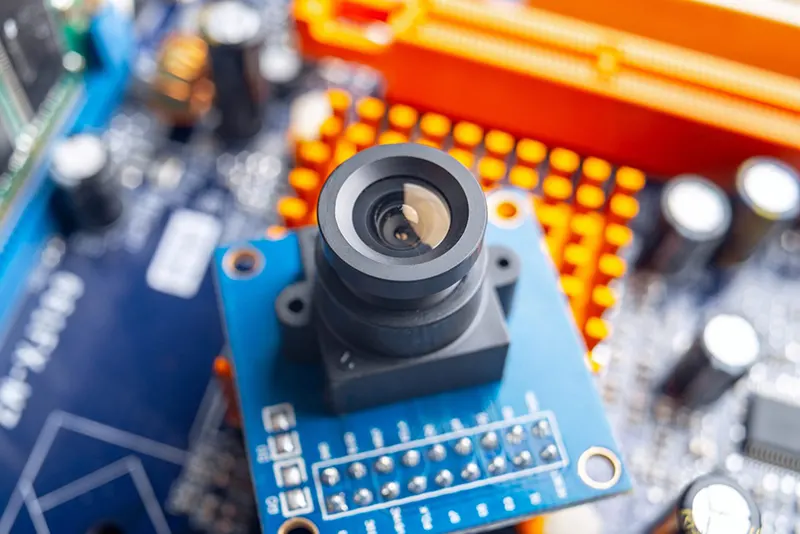En artikel: Vad är en linjesensorkamera
According to the structural characteristics of sensors, industrial cameras can be divided into area array cameras (area sensor cameras) and linear array cameras (linear sensor cameras). Area array cameras and linear array cameras have their own advantages and disadvantages. It is very important to choose the appropriate sensor structure for different purposes. Today, Xiaojin focuses on some knowledge points of linear sensor cameras:

1. What is a wire sensor camera?
Linear sensor camera, also known as linear array sensor camera, captures an image with one line and makes a single image. The feature of the area sensor camera is to capture the entire field of view at one time.
With a line sensor camera, a two-dimensional image can be obtained by continuously shooting an object while moving the object vertically relative to a row of photodiodes.
Compared with the area sensor camera, the line sensor camera does not need image synthesis when acquiring a long horizontal image, so it is good at capturing the subtle changes that occur pixel by pixel.
2. Application of line sensor camera
The application objects that the wire sensor camera is good at include objects with large size and objects requiring high precision resolution.
For example, when shooting large objects, if the area sensor is used, the segmentation shooting method is used. Because the seam may have defects, the splicing process is very important and difficult. If a wire sensor is used, a single image can be taken, so there is no need to connect images.
The line sensor has a wide range of applications: from the inspection of social infrastructure such as roads and exterior walls, to the industrial inspection of non-woven fabrics, gears, semiconductor parts, etc., to the analysis of works of art and the sorting of fruits, effectively replacing visual inspection.

3. Principle of wire sensor camera
Like ordinary cameras, line sensor cameras convert the light of the lens into images on imaging devices (such as CCD or CMOS), convert them into electronic signals, and output them as images.
The line sensor camera acquires a long horizontal image by continuously photographing the object and moving in the vertical direction relative to the image sensor composed of a row of photodiodes.
Wire sensor cameras are roughly divided into models that can acquire monochrome images and models that can acquire color (or invisible light) images. The model that can acquire color images has a multi-layer structure and has 1 to 3 rows of photodiodes. Because a photodiode can only provide one color information.
The three line color sensor captures a specific pixel through three photodiodes, which can obtain blue, green and red information. The single row color sensor uses a photodiode to capture a specific pixel, so only a single color information can be obtained. Därför, since the color information of a specific pixel is estimated based on the surrounding color information, the color accuracy is not as good as that of a three line color sensor.
4. Line sensor camera resolution
The selection of line sensor camera is mainly based on the comprehensive judgment of the resolution of the target system to be moved, the distance from the workpiece, the amount of light, etc. As a reference when making this decision, the characteristics and trends of line sensor cameras are as follows:
1:It is the exposure control. Generally speaking, most linear scanning cameras do not have exposure control, and the brightness of the light source must be manually changed to respond to speed fluctuations. Dessutom, it also adopts the method of changing parameters with speed.
However, through the electronic shutter, I can always shoot at the same exposure time. Even if the speed changes, we can shoot at the same brightness.
2:High speed. The camera with a throughput of 640 Mbyte/s is the highest speed camera in the market.
3:High sensitivity. Traditional line cameras need a strong light source because they can only use the exposure time for line scanning. Därför, the sensor itself uses an efficient sensor with an aperture ratio of 100%.
Dessutom, the time delay integration technology is also used to improve the sensitivity dozens of times, which is very suitable for high-speed scanning where the amount of light cannot be increased.
4:Shadow correction. Line sensor cameras can compensate for small differences in sensitivity within pixels in real time. This tool can also be used for shadow correction, som är, to correct the light intensity change in the width direction caused by uneven lighting.
Founded in 2015, Shenzhen Jinshikang Technology Co., Ltd. specializes in providing various camera module products such as monocular and binocular cameras. After years of development, it has accumulated profound experience in video capture, video intelligent analysis, and vehicle electronic technology. It has independently developed various differentiated camera modules such as object recognition, face recognition, iris recognition, and is widely used in new retail, face recognition, intelligent monitoring, industrial applications, and various image schemes. JSK is a high-tech enterprise integrating R&D, production, sales and service. Its products are sold at home and abroad and become the designated supplier of many listed companies. Relevant module products can be customized and developed according to the actual requirements of customers. Welcome camera module manufacturers and partners to visit our company and discuss cooperation.
